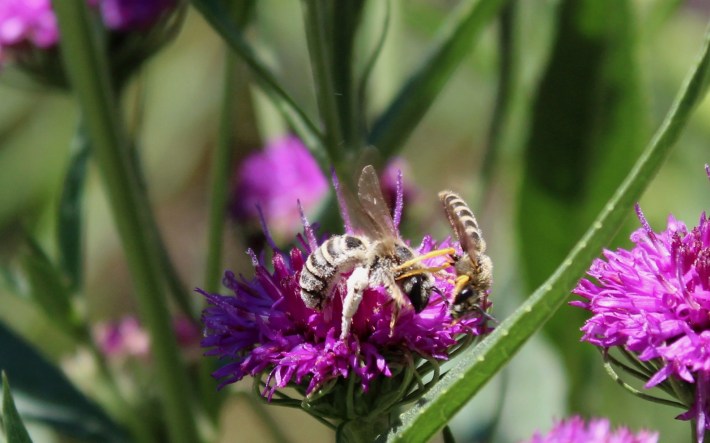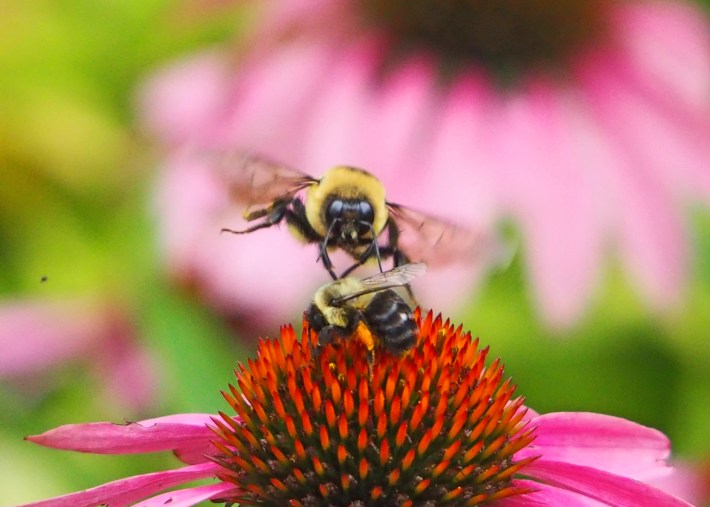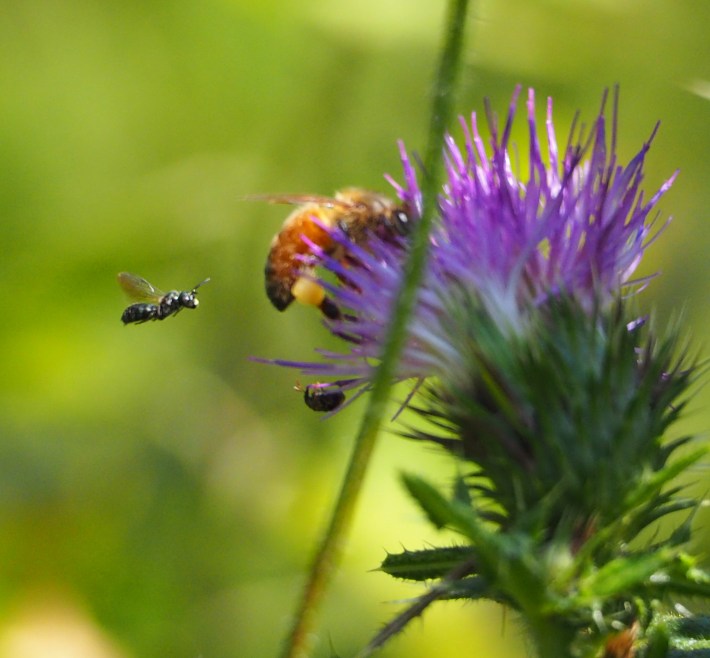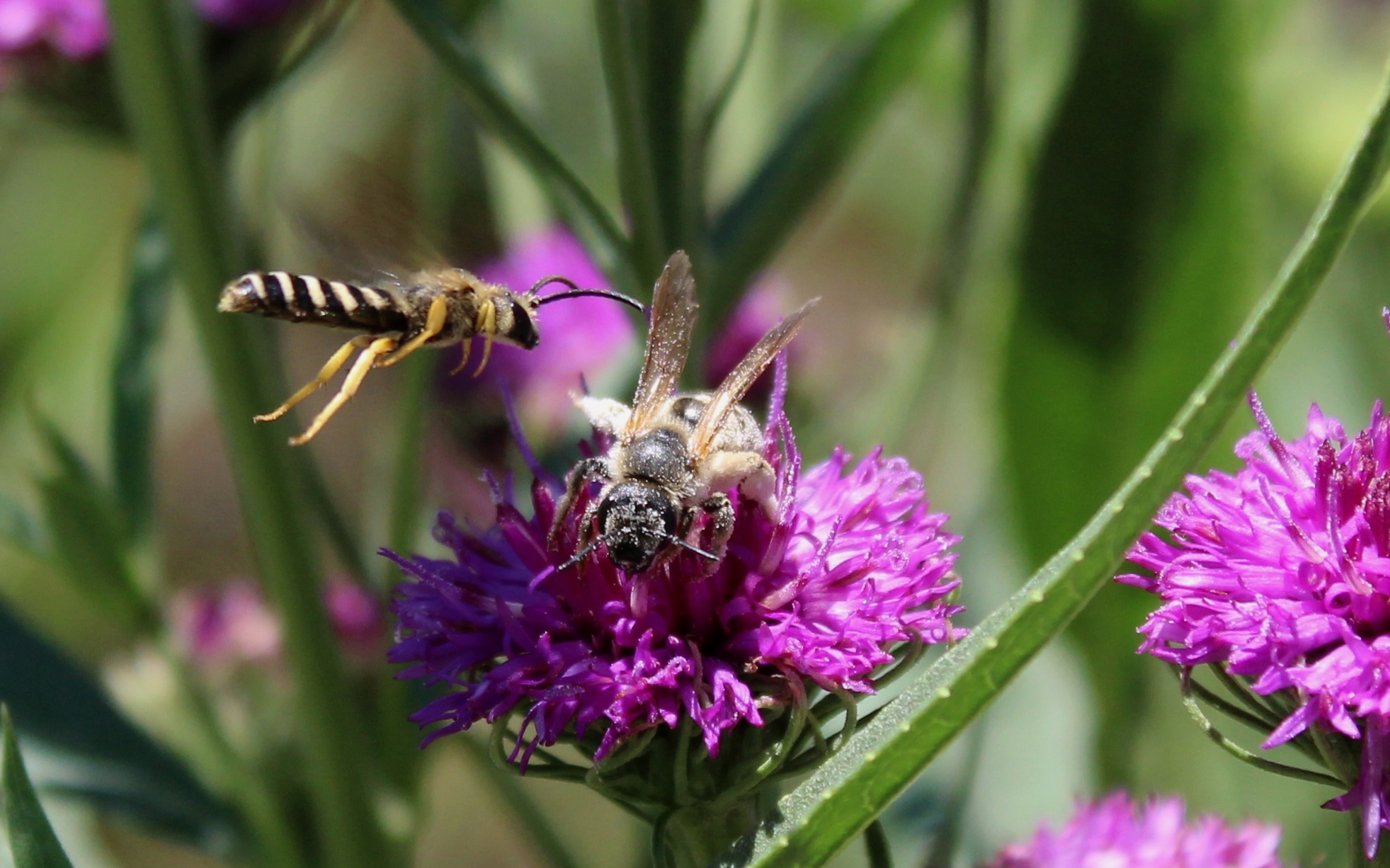In our human imagination, pollinating might seem an idyllic pastime. Buzzing from flower to beautiful flower to sip nectar and dust one's hairy body with pollen surely beats even the cushiest 9-to-5. But a day in the life of a honeybee is only partly sunshine and roses. Lounging on a flower places them at risk of attack by another insect, such as a hoverfly that has set its compound eyes on the same delectable flower. An impatient hoverfly will eagerly dive-bomb and drive out a hapless honeybee, seizing the flower for its own as the bee bumbles on to emptier pastures. In a paper published in December in the journal Ecology, two researchers document the insectoid intimidation that underlies even the most picturesque flower gardens.
Meredith Root-Bernstein, a conservation ecologist for CNRS at the Center for Ecology and Sciences of Conservation at the National Museum of Natural History in Paris and an author on the new paper, grew up watching these itty-bitty brawls in her parents' backyard in Michigan. "I remember there was one patch of tall flowers where I used to observe lots of insects landing on flowers," she said. "It didn’t take long to observe that they were dive-bombing one another, pouncing on each other, wrestling together, and so on."

As Root-Bernstein watched, she paid attention to which insect species tended to pick flower fights. The winners of the brawls were not always the biggest bugs; sometimes the tiniest bees and flies were the most aggressive, taking on butterflies many times their size. "It seemed to me that there was a dominance hierarchy, and a surprising one," Root-Bernstein said. Even her dad got into the mini-matches, and over the years would send her photos of insects fighting on flowers. At some point, Root-Bernstein turned her observations into a card game about insects fighting each other (the card game has been lost to time).
Even though Root-Bernstein could watch the fights, she could not find any scientific papers describing the specific behavior. Occasionally, papers would vaguely acknowledge that different species "interact" on flowers but did not specify what kinds of interactions, she said. Her interest was piqued. "It's always very satisfying to do a very simple study that documents something that is not hard to observe, yet is quite surprising," she said.
Aaron Fairweather, a graduate student at the University of Guelph in Ontario who was not involved in the research, has observed similar acts of aggression in their own research, between ants and pollinators on squash flowers. "These kinds of dominance hierarchies have been documented numerous times over the past century, however we are only starting to tease apart the complexities of the relationships at an invertebrate community scale," they said.
These simple studies raise important questions. For example, models of inter-species interactions do not predict this pattern of behavior, instead suggesting aggression over resources such as flowers would lead to local extinction of the losing species, or drawing firm lines between different species' turfs. But this prediction does not square with the constant, low-stakes aggression Root-Bernstein observed over the years. "There are no theories about animal behavior that explain why different species should be in direct and constant aggression over a resource, with none of them ever winning or getting any clear advantage," she said.

After Root-Bernstein started her job at the Natural History Museum in Paris, she got funding for Thomas Renaud, an author on the paper who was then doing an internship at the museum's center for ecology and sciences of conservation. Renaud, now a master's student at the University of Poitiers, spent a week visiting about 20 local park locations, scouting for sites with known insect visitors and dense patches of healthy flowering plants. "We thought that a high density of flowers would maximize the probability of presence of insects and possibly the aggressive behaviors," Renaud said. In the spring of 2022, when Renaud first unfurled his camping chair to stare at flowers for 45 uninterrupted minutes, some people stared. But they eventually ignored him, as if he had become a part of the park.
Before they started collecting data, Root-Bernstein and Renaud suspected the honeybees might wind up near the top of the hierarchy, as hives of honeybees can outperform wild bees and dominate floral resources. "We expected a certain dominance from them," Renaud said.
They were surprised to learn the opposite was true—the large and fuzzy honeybees were invariably the victims, not the aggressors. After 48 total hours of observation, the researchers identified 1,374 interactions, 67 percent of which were aggressive. The prime instigators behind many of these attacks were hoverflies, a family of flies named for their habit of hovering at flowers. Hoverflies are harmless to humans, but many species bear uncanny resemblances to stinging bees or wasps, likely for protection. The largest hoverflies, along with gray bees in the family Anthophora, were largely responsible for the attacks. Bumblebees and honeybees were much calmer and more peaceful, however even the bumblebees targeted the honeybees.
Fairweather also found it "quite fascinating" that stinging bees were often not aggressors, despite their obvious weaponry, and praised the level of detail the authors included for each species. "Breaking down the nuances of how these species compete or cooperate for resources is really interesting, and illustrates how complex insect behavior really can be, a fact often overlooked," they said.

What astonished Renaud the most was the apparently premeditated nature of the attacks. Some of the insect aggressors did not just hover over other insects sampling the flower; they pursued them to other flowers or chased them in flight. None of the insects appeared physically injured after these fights. But "I could not assess their psychological health," Renaud added.
So here is the dominance hierarchy of the insects of certain gardens in Paris, with large hoverflies at the very top and humble honeybees at the bottom.







